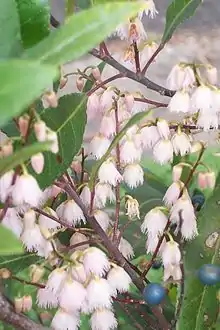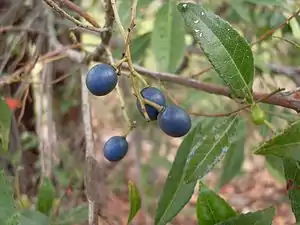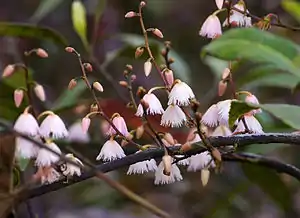Elaeocarpus reticulatus
Elaeocarpus reticulatus, the blueberry ash, is an endemic tree native to Australia, occurring all along the east coast from Fraser Island, Queensland to Flinders Island, Tasmania.[1] Other common names include: ash quandong, blue olive berry, fringe tree, lily of the valley tree, scrub ash, fairy Petticoats, koda, and perhaps even prima donna.[2]
| Blueberry ash | |
|---|---|
 | |
| Flowers and fruit | |
| Scientific classification | |
| Kingdom: | Plantae |
| Clade: | Tracheophytes |
| Clade: | Angiosperms |
| Clade: | Eudicots |
| Clade: | Rosids |
| Order: | Oxalidales |
| Family: | Elaeocarpaceae |
| Genus: | Elaeocarpus |
| Species: | E. reticulatus |
| Binomial name | |
| Elaeocarpus reticulatus | |
| Synonyms | |
The fruit’s edible outer skin and mesocarp (soft inner layer of the fruit) excluding the seed is safe to eat and is used in Australian Aboriginal Cuisine such as Bush tucker tea and is used in making jam. Its hard seed makes up most of the fruit in diameter. Botanically, the fruits are not true berries but drupes.[1][3] It is especially grown to attract wildlife such as bees, nectar eating birds, seed eating birds, and butterflies.[4]
Description and Distribution [Habitat]
This evergreen tree grows 3–15 m (9.8–49.2 ft) tall and 1–5 m (3.3–16.4 ft) wide.[5] Although, when this large shrub or tree is situated in one of the Rainforests in New South Wales, or Queensland it can attain a height of 30 metres with the right climate conditions while competing for light with other taller trees.[6] Its most conspicuous features are the masses of white or sometimes pinkish cup-shaped flowers with fringed edges arranged in rows along the branch-let (A subdivision of a branch that is near or at the tip of the branch) which droop downwards giving them the dainty appearance of small hanging skirts.[1] Another beautiful feature of this species is the round-oval drupaceous fruits, these are a stunning shade of bright blue and if you look closer there are a few tiny white yellowish spots all over the fruit's smooth surface, and would resemble small (1 cm long) olives.[1]
"The leathery leaves (to 12cm long) are lanceolate with a slightly elongate drip-tip apex and serrated margins. An interesting feature displayed in some of the leaves is a fine, whitish crust or film over the surface, giving the appearance of an evaporated salt layer. As the leaves age, they turn a bright red whilst still on the tree, providing an appealing colour contrast with the dark green foliage". When this blueberry ash tree is pruned new growth of leaves would start appearing up an attractive pinkish colour.[7]
This is a hardy plant native to eastern Australia grows under many conditions, however prefers warmer Temperate climate conditions along the coast. It descends from rainforest-like environments where it can be founded in southeastern Queensland, in eastern New South Wales, and on Flinders Island situated in Tasmania, but has shifted its range to include the drier climate of south-eastern Australia (its leaves have become harder for example). In New South Wales it grows in moist areas such as gullies and around watercourses as well as in tall Eucalyptus forests and sandy coastal scrub.[1]
Cultivation and Uses
Great tree for wildlife
The most commonly used name of Blueberry Ash is derived from these pretty fruits, which attract birds like the Regent bowerbird that collect them for their blue colour. Other birds that eat these fruits are Wonga Pigeons, Crimson Rosellas, Figbirds, White Headed Pigeons and Olive-backed Orioles.[1] This tree is excellent for landscape restoration and wildlife.
Food & cultivation
From an ABC episode of Gardening Australia, Bernie shows Clarence some favourite fruit trees in Booderee Botanic Gardens. "This is Blueberry Ash (Elaeocarpus reticulatus). It grows all along this escarpment here. It's good bush tucker tea. You can get the berries off and eat that up, you can crush it and make it into jam. The birds love them too, so it's part of their staple diet as well." It's a hard seed to germinate, the only way to propagate (cultivate) it is by lettings birds eat it and then collect the droppings which then would be use for cultivation of this tree.[3] Watch the small snippet of the episode here on this ABC website. https://www.abc.net.au/gardening/factsheets/booderee-botanic-gardens/9435908.
Fire retardant
In a bush fire Elaeocarpus reticulatus (Blueberry ash) does not recover vegetatively (side shoots) after it is burnt so it must regenerate from seed either stored in the soil or from seed dispersed to the area by birds, related species cannot recover from fire as well. Elaeocarpus reticulatus is fire Retardant - Plants in which because of natural characteristics will not ignite easily in a moderate intense bush fire.[8] In other words it's fire retardant although if it ignites during a big bush fire this tree would burn slower. However, it will not likely regrow back and will have to count on seeds already in the soil or from birds to grow back.
Gallery
.jpg.webp) Fairy Petticoats - (Elaeocarpus reticulatus) pinkish flower bulbs open up.
Fairy Petticoats - (Elaeocarpus reticulatus) pinkish flower bulbs open up. Elaeocarpus reticulatus (Blueberry ash) fruit.
Elaeocarpus reticulatus (Blueberry ash) fruit. Elaeocarpus reticulatus
Elaeocarpus reticulatus Elaeocarpus reticulatus closed flowers bulbs can come in pinkish colour.
Elaeocarpus reticulatus closed flowers bulbs can come in pinkish colour.
References
- Brown, Liz (2002). "Elaeocarpus reticulatus - Growing Native plants". Australian National Botanic Gardens.
- "Elaeocarpus reticulatus". keys.lucidcentral.org. Retrieved 2020-01-10.
- Booderee Botanic Gardens, Australian Broadcasting Corporation, 2014-09-27, retrieved 2020-01-09
- "Elaeocarpus reticulatus 'Prima Donna' – Blueberry Ash | Gardening With Angus". www.gardeningwithangus.com.au. Retrieved 2020-01-09.
- Brown, Liz (2002). "Elaeocarpus reticulatus - Growing Native plants". Australian National Botanic Gardens.
- Floyd, A.G., Rainforest Trees of Mainland South-eastern Australia, Inkata Press 1989, ISBN 0-909605-57-2
- Brown, Liz (2002). "Elaeocarpus reticulatus - Growing Native plants". Australian National Botanic Gardens.
- "Elaeocarpus angustifolius risk assessment". www.hear.org. Retrieved 2020-01-09.
External links
- Check the websites below for the dimensions and appearance of this tree in more detail.
- PlantNET New South Wales Flora Online: Elaeocarpus reticulatus
- https://keys.lucidcentral.org/Elaeocarpus reticulatus.htm